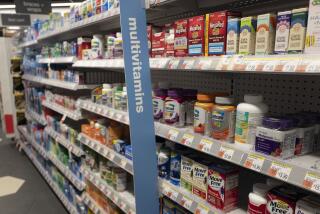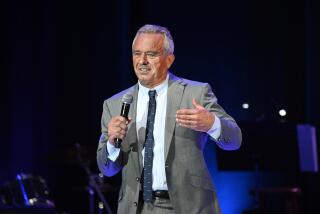More Dispute on Calcium Supplements
- Share via
The controversy over calcium supplements to ward off osteoporosis has been made murkier by two new research studies. The reports avoid the question of whether women should take extra calcium before menopause to avert bone loss later.
The researchers cautioned that the new studies apply only to the question of calcium supplements taken after menopause--in the crucial decade after menstruation ceases and post-menopausal bone loss is at its peak.
On that, the research from Denmark and the Kaiser Permanente Medical Center in San Francisco finds that calcium doesn’t accomplish much and post-menopausal estrogen supplements are more effective.
But Dr. Bruce Ettinger, the Kaiser Permanente expert who led one of the new studies--both appeared last week in medical journals--says the research doesn’t address a key question in women’s health care: Should women in their 20s, 30s and 40s take calcium to prevent bone from deteriorating later in their lives?
No Sure Answer
There remains no definitive answer, Ettinger said, though some current studies are trying to resolve the issue. This research, he said, will take years to complete. But for now, he said, taking calcium supplements is a sound strategy, even for teen-agers--hypothetically, at least. What counts most, Ettinger said, is the peak bone mass a woman reaches at age 35. It is all downhill after that, but calcium in adolescence is apparently crucial to bone mass at 35, and calcium supplements in young and middle-aged women may play a similar, if less dramatic, role.
“It comes down to the (probability) that calcium is not a bad idea,” he said. “It’s not harmful, and although there is very little evidence that giving high calcium intakes to women prevents osteoporosis, there’s the other argument that if it helps a little bit, why not use it?”
THE FLU AND YOU: 1987
Public health officials say there’s good flu news so far this season, but if you’re under 35 and miserable with a persistent case, you may be too sick to care.
This is because the nation’s most active flu strain this season is Taiwan A. It’s a classic influenza in most respects with typical symptoms including sniffles, fever, headache, sore throat, muscle ache and malaise. But it’s different in that instead of preying on the elderly, Taiwan A has generally left the very old alone and socked it to the young.
In most senses, said Dr. Robert Murray of the California Department of Health Services, this is good because flu usually doesn’t kill or disable otherwise healthy young patients, but it does have the capacity to be serious or fatal in the old.
So flu this year, said Dr. Steve Waterman of the Los Angeles County Health Department, has been visible when it has disabled college basketball teams and caused absenteeism in schools, but really no more prevalent than usual.
A vaccine is available--for older patients and those under 35 with chronic diseases.A prescription drug called amantadine (brand name: Symmetrel) is effective, but should be initiated within two days of the onset of flu symptoms.
“We don’t have an epidemic,” Murray said. “We have a lot, but no more than we would expect for this time of year.”
GAS TAXES AND HEALTH
It has long been argued there is a direct link between cigarette tax rates and the amount that people smoke, with high taxes cutting use and lowering the number of people who die of smoking-related causes. Now, two economists have extended the principle to an argument in favor of increasing gasoline taxes--setting them at 10% to as much as 40% of current retail prices--as a way to save lives and prevent injuries. Some prominent safety experts are skeptical, though.
The argument surfaced in a letter to the editor in the New England Journal of Medicine. Economists from San Jose State and the University of Kentucky estimated that price-related changes in driving habits might save 3,000 to 15,000 lives a year if the gasoline tax rose to 40% of the price range. A 10% tax might save 750 to 3,900 lives a year. The current retail price of gasoline includes 18 cents in state and federal taxes. The proposed levy would be in addition to the existing total price of gasoline.
But Johns Hopkins University safety researcher Susan Baker was skeptical. She said driving most often linked to fatal accidents--comparatively short trips near the home in which alcohol plays a role--is not likely to be reduced by gasoline taxes. Long-distance driving, which probably would be affected by a tax hike, has the lowest fatality rates.
Baker said the 55 m.p.h. speed limit was credited with saving 6,000 lives a year when it was mandated in the early 1970s and a gasoline tax hike is highly unlikely to do better.
“People probably won’t think about gasoline taxes when they go to a party, a bar or the movies on a Friday night,” she said, “but they may think long and hard before they drive to California.”
DOCTOR’S LEXICON
Heart attacks aren’t all the same, but the most common variety is one lay people may have heard doctors call by its technical shorthand term, MI.
The initials stand for myocardial infarction, or an episode in which a small area of tissue in the myocardium , or the muscle walls of the heart, becomes an infarct , deteriorating in a process very much like rotting away. The muscle fails at the site of the infarct and the heart seizure occurs.






